WBR0576: Difference between revisions
Jump to navigation
Jump to search
YazanDaaboul (talk | contribs) No edit summary |
YazanDaaboul (talk | contribs) No edit summary |
||
| Line 2: | Line 2: | ||
|QuestionAuthor={{Rim}} (Reviewed by {{YD}}) | |QuestionAuthor={{Rim}} (Reviewed by {{YD}}) | ||
|ExamType=USMLE Step 1 | |ExamType=USMLE Step 1 | ||
|MainCategory= | |MainCategory=Pathophysiology | ||
|SubCategory=Neurology | |SubCategory=Neurology | ||
|MainCategory= | |MainCategory=Pathophysiology | ||
|SubCategory=Neurology | |SubCategory=Neurology | ||
|MainCategory= | |MainCategory=Pathophysiology | ||
|SubCategory=Neurology | |SubCategory=Neurology | ||
|MainCategory= | |MainCategory=Pathophysiology | ||
|MainCategory= | |MainCategory=Pathophysiology | ||
|MainCategory= | |MainCategory=Pathophysiology | ||
|SubCategory=Neurology | |SubCategory=Neurology | ||
|MainCategory= | |MainCategory=Pathophysiology | ||
|SubCategory=Neurology | |SubCategory=Neurology | ||
|MainCategory= | |MainCategory=Pathophysiology | ||
|SubCategory=Neurology | |SubCategory=Neurology | ||
|MainCategory= | |MainCategory=Pathophysiology | ||
|SubCategory=Neurology | |SubCategory=Neurology | ||
|MainCategory= | |MainCategory=Pathophysiology | ||
|MainCategory= | |MainCategory=Pathophysiology | ||
|SubCategory=Neurology | |SubCategory=Neurology | ||
|Prompt=A 55-year-old woman with poor medical follow-up | |Prompt=A 55-year-old woman with poor medical follow-up presents with ulcers on the soles of her feet. Upon questioning, the patient reports lower extremity numbness and imbalance for the past 3 months. She also complains of occasional urinary incontinence and shooting pains in her abdomen and back, which she sometimes attributed to indigestion. On physical examination, the physician notices bilateral miotic pupils that are non-reactive to light but are reactive to accomodation. He also notes the presence of foot ulcers, diminished reflexes in the lower extremities, and a wide-based, slapping gait. Which of the following images depict the spinal cord lesions that are most likely responsible for the patient's condition (lesion in red)? | ||
|Explanation=[[Tabes dorsalis]] is a | |Explanation=[[Tabes dorsalis]] is a parenchymatous neurosyphilis disorder that is characterized by progressive degeneration of the posterior columns, roots, and ganglia of the spinal cord, which usually carry the proprioception, pressure, vibration, and touch sensory pathways. Manifestations of tabes dorsalis classically include shooting pains, ataxia, areflexia, Argyll-Roberston pupils (also called prostitute pupils because they accomodate but do not react), and positive Romberg sign. Other non-specific features may include bowel and bladder dysfunction such as urinary incontinence, gastric pains, impotence, visual loss, Charcot's arthopathy, wide-based slapping gate, and foot ulcerations. Unlike other forms of CNS involvement in syphilis, (eg syphilis meningitis), the hallmark of tabes dorsalis is the onset of symptoms several years following the initial exposure to syphilis. The delay period from initial exposure to the development of tabes dorsalis may take up to 5-30 years if syphilis was left untreated. In tabes dorsalis, positive RPR or VDRL in the serum and in the CSF are suggestive of previous or current neurosyphilis. In contrast, isolation of ''T. pallidum'', the organism responsible for syphilis, from CSF in tabes dorsalis is unusual, suggesting a rather immunological disorder that affects the dorsal columns of the spinal cord in tabes dorsalis due to untreated syphilis rather than an infectious process. Treatment with [[penicillin]] stops the progression of tabes dorsalis but cannot reverse the injury that has already been made. | ||
|AnswerA=[[Image:WBR0570C.gif|300px]] | |AnswerA=[[Image:WBR0570C.gif|300px]] | ||
|AnswerAExp=This image depicts the involvement of the dorsal columns of the [[spinal cord]] that | |AnswerAExp=This image depicts the involvement of the dorsal columns of the [[spinal cord]] that carry the ascending [[proprioception]], pressure, touch, and vibration sensory pathways. Involvement of the posterior columns, roots, and ganglia of the spinal cord is characteristic of tabes dorsalis caused by neurosyphilis. | ||
|AnswerB=[[Image:WBR0570E.gif|300px]] | |AnswerB=[[Image:WBR0570E.gif|300px]] | ||
|AnswerBExp=This image typically depicts spinal cord lesions | |AnswerBExp=This image typically depicts spinal cord lesions consistent with ALS. ALS may involve both the descending corticospinal tracts (upper motor neurons) and the anterior horns (lower motor neurons). The involvement of both the upper and lower motor neuron pathways is the hallmark of ALS. | ||
|AnswerC=[[Image:WBR0570D.gif|300px]] | |AnswerC=[[Image:WBR0570D.gif|300px]] | ||
|AnswerCExp=This image depicts isolated anterior horn injury | |AnswerCExp=This image depicts isolated anterior horn injury suggestive of [[poliomyelitis]] or [[Werdnig-Hoffman syndrome]] (floppy baby syndrome). | ||
|AnswerD=[[Image:WBR0570B.gif|300px]] | |AnswerD=[[Image:WBR0570B.gif|300px]] | ||
|AnswerDExp=This image depicts multiple, non-patterned white matter lesions | |AnswerDExp=This image depicts multiple, non-patterned white matter lesions characteristic of [[multiple sclerosis]]. | ||
|AnswerE=[[Image:WBR0570A.gif|300px]] | |AnswerE=[[Image:WBR0570A.gif|300px]] | ||
|AnswerEExp=This image is depicts an expanding central canal compressing adjacent tracts typically seen in [[syringomyelia]]. The anterior white commissure is the closest structure which leads to compression of the decussating spinothalamic tracts first. | |AnswerEExp=This image is depicts an expanding central canal compressing adjacent tracts typically seen in [[syringomyelia]]. The anterior white commissure is the closest structure which leads to compression of the decussating spinothalamic tracts first. | ||
|EducationalObjectives=Tabes dorsalis is | |EducationalObjectives=[[Tabes dorsalis]] is a parenchymatous neurosyphilis disorder that is characterized by progressive degeneration of the posterior columns, roots, and ganglia of the spinal cord. | ||
|References=Lanska DJ. The suspension apparatus for tabes dorsalis. Neurology. 1999;52(6):1295.<br> | |References=Lanska DJ. The suspension apparatus for tabes dorsalis. Neurology. 1999;52(6):1295.<br> | ||
Chahine LM, Khoriaty RN, Tomford WJ, Hussain MS. The changing face of neurosyphilis. Int J Stroke. 2011;6(2):136-43.<br> | Chahine LM, Khoriaty RN, Tomford WJ, Hussain MS. The changing face of neurosyphilis. Int J Stroke. 2011;6(2):136-43.<br> | ||
|RightAnswer=A | |RightAnswer=A | ||
|WBRKeyword=Tabes dorsalis, Syphilis, Dorsal columns | |WBRKeyword=Tabes dorsalis, Syphilis, Dorsal columns, Posterior columns, Proprioception, Pressure, Vibration, Touch, Romberg, Argyll-Robertson pupil, Argyll, Robertson, Pupil, Pupils | ||
|Approved=No | |Approved=No | ||
}} | }} | ||
Revision as of 16:09, 16 October 2014
| Author | [[PageAuthor::Rim Halaby, M.D. [1] (Reviewed by Yazan Daaboul, M.D.)]] |
|---|---|
| Exam Type | ExamType::USMLE Step 1 |
| Main Category | MainCategory::Pathophysiology |
| Sub Category | SubCategory::Neurology |
| Prompt | [[Prompt::A 55-year-old woman with poor medical follow-up presents with ulcers on the soles of her feet. Upon questioning, the patient reports lower extremity numbness and imbalance for the past 3 months. She also complains of occasional urinary incontinence and shooting pains in her abdomen and back, which she sometimes attributed to indigestion. On physical examination, the physician notices bilateral miotic pupils that are non-reactive to light but are reactive to accomodation. He also notes the presence of foot ulcers, diminished reflexes in the lower extremities, and a wide-based, slapping gait. Which of the following images depict the spinal cord lesions that are most likely responsible for the patient's condition (lesion in red)?]] |
| Answer A | [[AnswerA::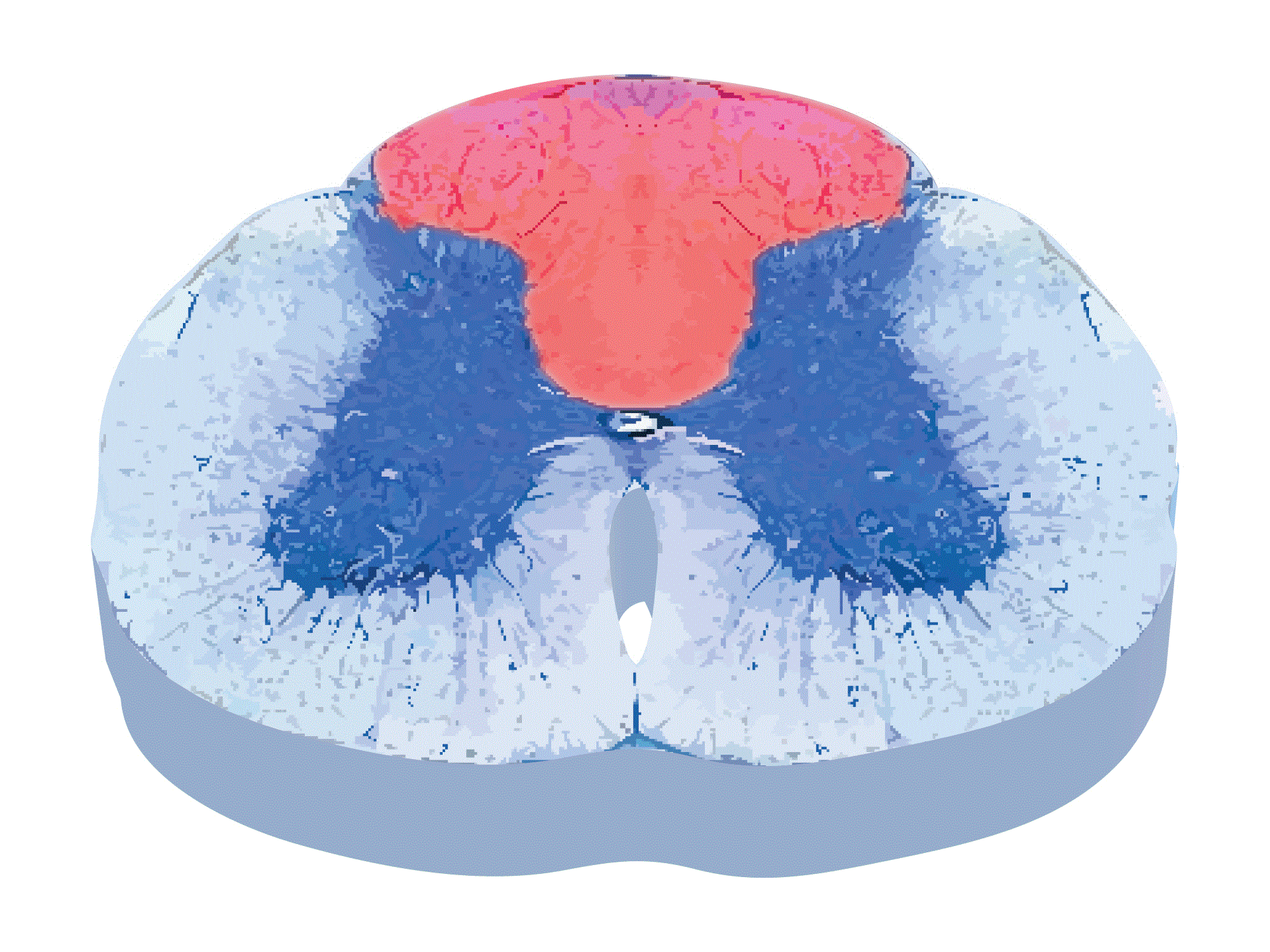 ]] ]]
|
| Answer A Explanation | [[AnswerAExp::This image depicts the involvement of the dorsal columns of the spinal cord that carry the ascending proprioception, pressure, touch, and vibration sensory pathways. Involvement of the posterior columns, roots, and ganglia of the spinal cord is characteristic of tabes dorsalis caused by neurosyphilis.]] |
| Answer B | [[AnswerB::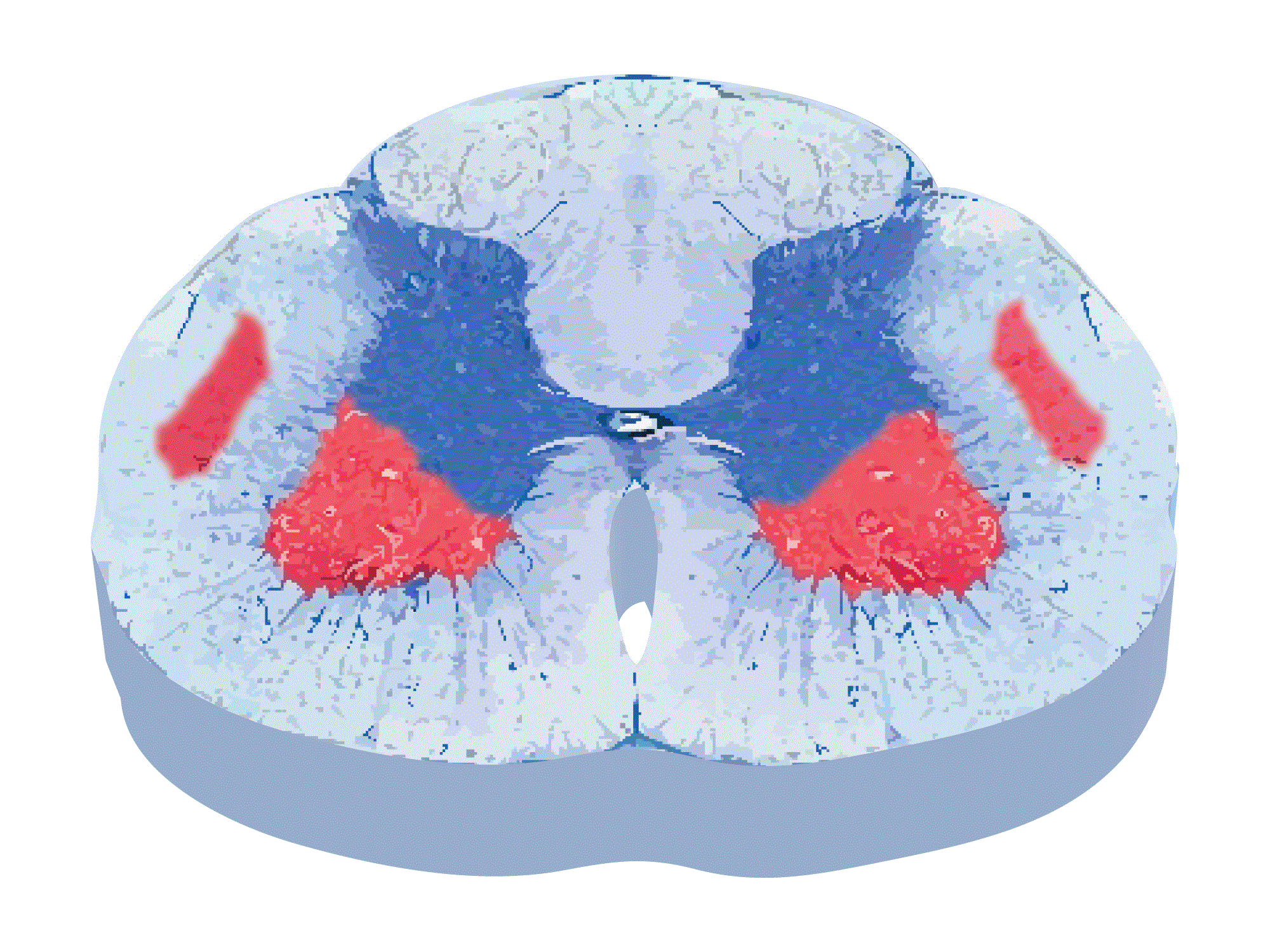 ]] ]]
|
| Answer B Explanation | [[AnswerBExp::This image typically depicts spinal cord lesions consistent with ALS. ALS may involve both the descending corticospinal tracts (upper motor neurons) and the anterior horns (lower motor neurons). The involvement of both the upper and lower motor neuron pathways is the hallmark of ALS.]] |
| Answer C | [[AnswerC::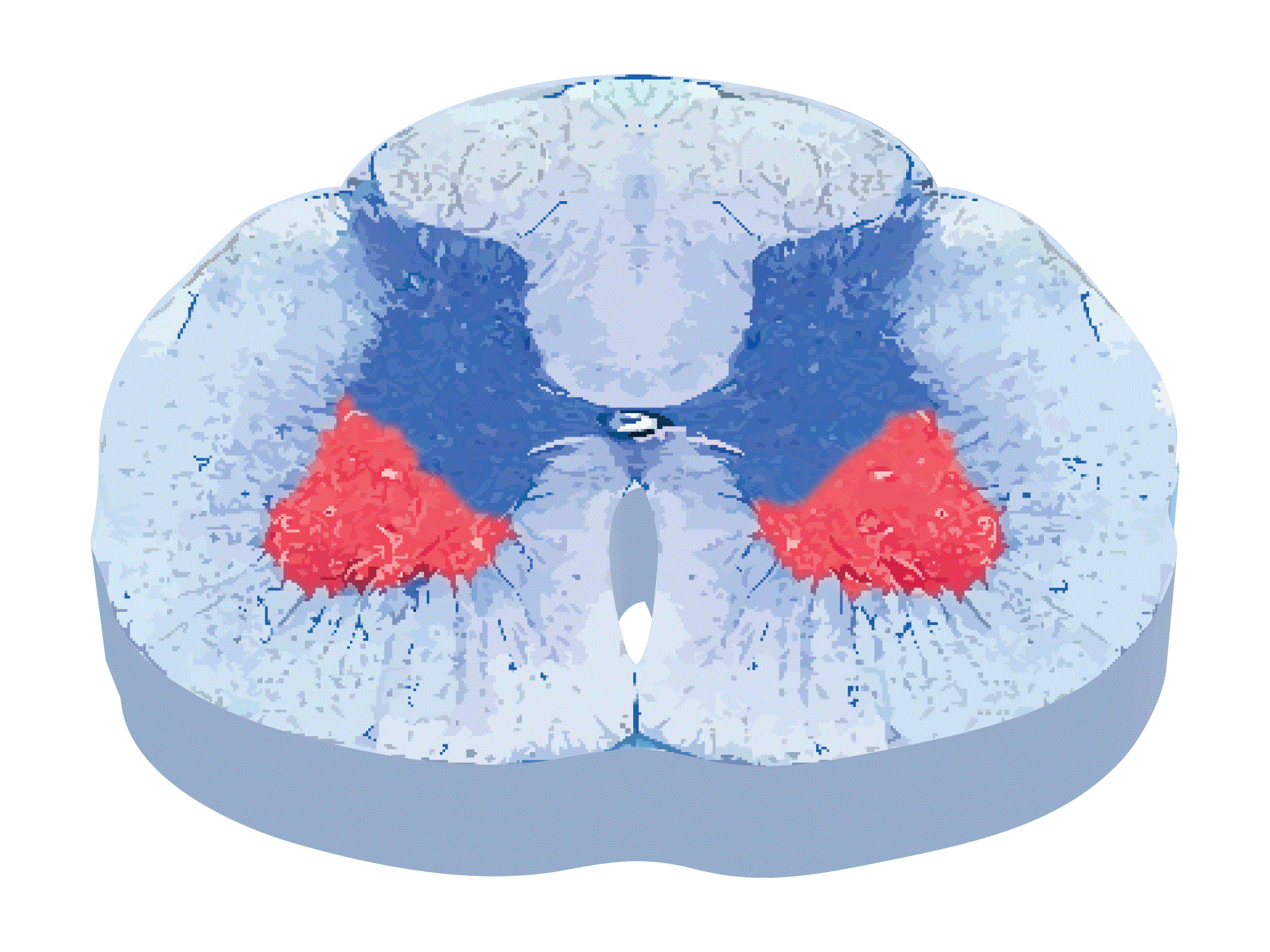 ]] ]]
|
| Answer C Explanation | [[AnswerCExp::This image depicts isolated anterior horn injury suggestive of poliomyelitis or Werdnig-Hoffman syndrome (floppy baby syndrome).]] |
| Answer D | [[AnswerD::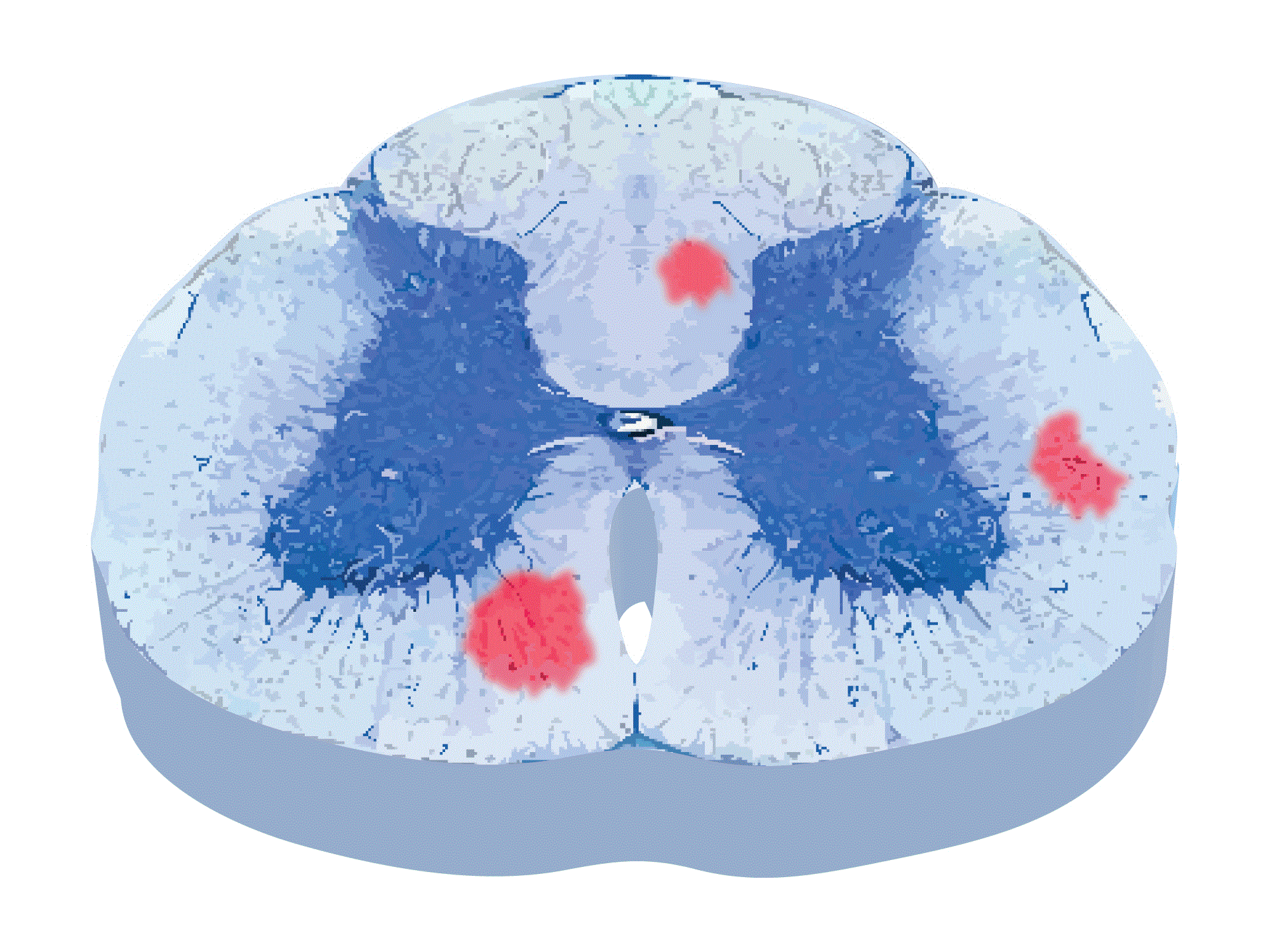 ]] ]]
|
| Answer D Explanation | [[AnswerDExp::This image depicts multiple, non-patterned white matter lesions characteristic of multiple sclerosis.]] |
| Answer E | [[AnswerE::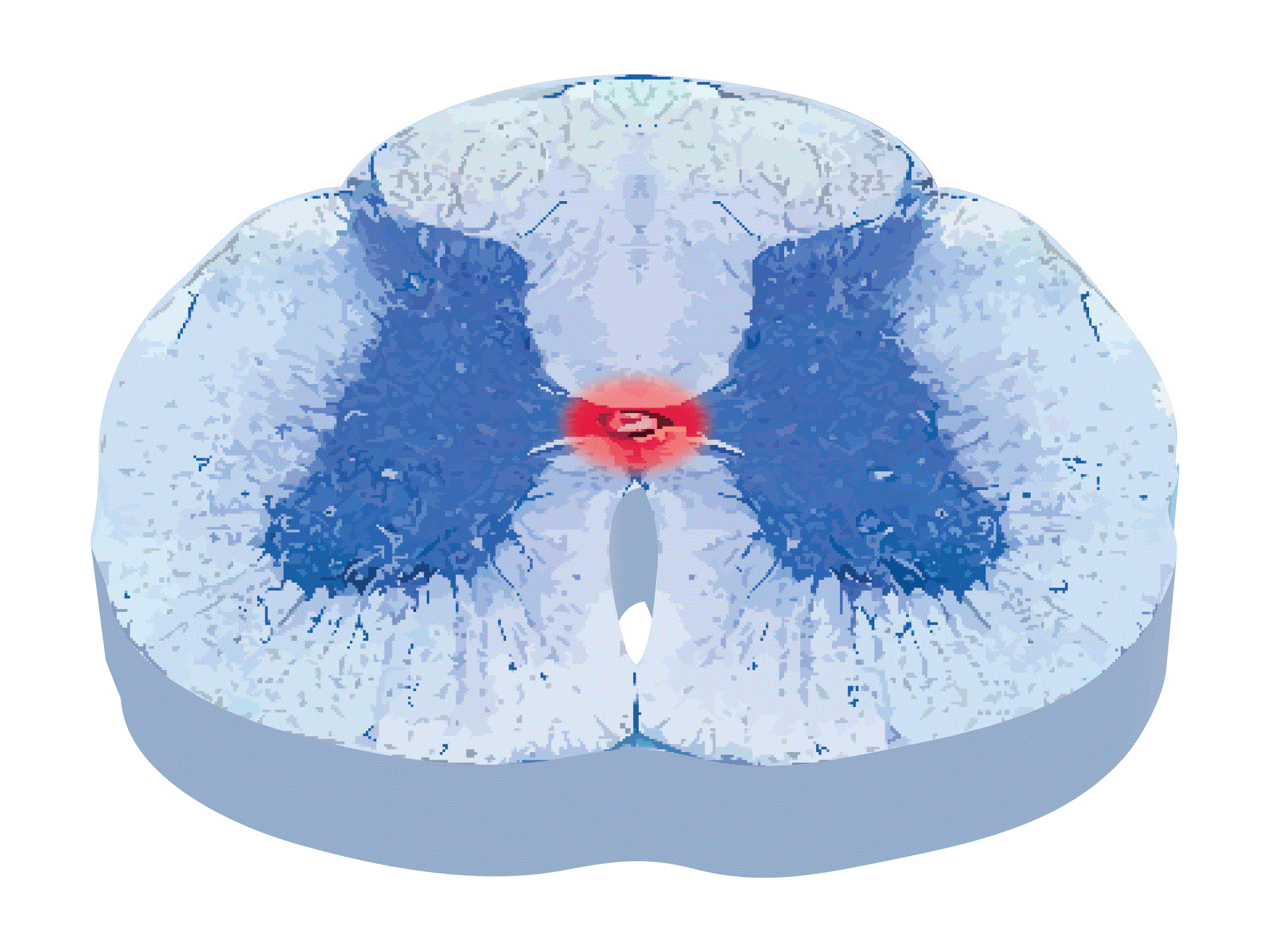 ]] ]]
|
| Answer E Explanation | [[AnswerEExp::This image is depicts an expanding central canal compressing adjacent tracts typically seen in syringomyelia. The anterior white commissure is the closest structure which leads to compression of the decussating spinothalamic tracts first.]] |
| Right Answer | RightAnswer::A |
| Explanation | [[Explanation::Tabes dorsalis is a parenchymatous neurosyphilis disorder that is characterized by progressive degeneration of the posterior columns, roots, and ganglia of the spinal cord, which usually carry the proprioception, pressure, vibration, and touch sensory pathways. Manifestations of tabes dorsalis classically include shooting pains, ataxia, areflexia, Argyll-Roberston pupils (also called prostitute pupils because they accomodate but do not react), and positive Romberg sign. Other non-specific features may include bowel and bladder dysfunction such as urinary incontinence, gastric pains, impotence, visual loss, Charcot's arthopathy, wide-based slapping gate, and foot ulcerations. Unlike other forms of CNS involvement in syphilis, (eg syphilis meningitis), the hallmark of tabes dorsalis is the onset of symptoms several years following the initial exposure to syphilis. The delay period from initial exposure to the development of tabes dorsalis may take up to 5-30 years if syphilis was left untreated. In tabes dorsalis, positive RPR or VDRL in the serum and in the CSF are suggestive of previous or current neurosyphilis. In contrast, isolation of T. pallidum, the organism responsible for syphilis, from CSF in tabes dorsalis is unusual, suggesting a rather immunological disorder that affects the dorsal columns of the spinal cord in tabes dorsalis due to untreated syphilis rather than an infectious process. Treatment with penicillin stops the progression of tabes dorsalis but cannot reverse the injury that has already been made. Educational Objective: Tabes dorsalis is a parenchymatous neurosyphilis disorder that is characterized by progressive degeneration of the posterior columns, roots, and ganglia of the spinal cord. |
| Approved | Approved::No |
| Keyword | WBRKeyword::Tabes dorsalis, WBRKeyword::Syphilis, WBRKeyword::Dorsal columns, WBRKeyword::Posterior columns, WBRKeyword::Proprioception, WBRKeyword::Pressure, WBRKeyword::Vibration, WBRKeyword::Touch, WBRKeyword::Romberg, WBRKeyword::Argyll-Robertson pupil, WBRKeyword::Argyll, WBRKeyword::Robertson, WBRKeyword::Pupil, WBRKeyword::Pupils |
| Linked Question | Linked:: |
| Order in Linked Questions | LinkedOrder:: |